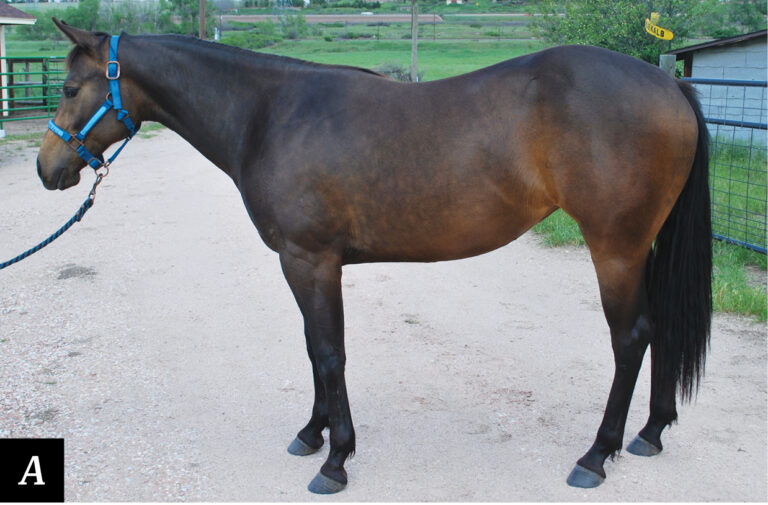In the last five to 10 years, we’ve seen a shift back to more active trail riding. People are getting out, both alone and in groups, going to trail riding events, and enjoying themselves.
As people are reconnecting with their horses outside of the arena, I’ve seen nerves surface. They’re finding trickier trail terrain to cross or are taking horses that are used to arena environments out into nature for the first time.
I’ve been fortunate to trail ride across nearly every type of terrain in the United States and in every region. Here, I want to share exercises to do before heading out and tips to help you stay safe on the trail.

Overcoming Obstacles
If my horse is scared of an obstacle, I’m going to take my time working him through his fears. No matter the terrain, the first thing I do is have my horse look at the obstacle in question. If my horse looks away, or tries to avoid the obstacle all together, I squeeze my legs and ask for forward momentum immediately. I’m going to keep gently increasing the pressure until my horse looks where I want him to look, and as soon as he does so, I’m going release
the pressure.
If he’s refusing to go forward because he’s scared, it’s important to slow down and take your time approaching the obstacle. The harder you push him, the more you’re going to scare him, which is only going to elevate the intensity of the situation.
If my horse starts to lift his head and not pay attention to the obstacle in question, I’m going to immediately attempt to shift his gaze back to it. This is why it’s very important for you to be paying attention to your horse’s expression and where he’s looking.
To do that, I’m going to once again use my legs to ask for forward momentum until my horse steps forward one step. I release after each step as a reward, paying close attention to my timing. Eventually, we are over the obstacle.
Don’t try to rush the process. I see people have such messes over high logs and downed timber because they keep pushing until finally, their horse launches in the air and over the obstacle. Instead, you need to sit back, wait, and focus on your timing with pressure and release. Keep your horse’s nose locked on what’s scaring him until he finally accepts it, steps forward, and moves over it on his own.

Speed Control
Horses are herd animals. If you watch a pasture full of them, you’ll notice they bolt and run together. When you’re riding on the trail with a group, your horse is naturally drawn along by the herd. If the herd is leaving at a faster rate of speed, your horse’s instinct is to go with it. You must have enough control over him to keep him from following. That control is not developed at the trot and not developed at the lope. It’s developed through practice before those moments arise. Ray Hunt put it best: If you want to stop a wreck, you have to know what happens before it happens.
Ride Your Horse
One mistake I see trail riders do is not truly ride their own horse. Let me give you an example: If the first horse in line spooks, what does the third horse do? In a lot of cases, he spooks, as well—maybe even bigger. Yet the horse didn’t see what was really causing the fear. That’s because you’re not riding your horse. The person on the horse in front is riding your horse, and your horse is reacting to what they do.
To prevent this from happening on a trail, I’ll play a game of leapfrog at home either in my arena or in a pasture. I’ll pass one horse and then that person will pass three horses, and we just keep leapfrogging. That way, I am guiding my horse and in control of his action
and reaction.
Keep Control
When you’re out on that trail and your friends want to go into a faster gait, but you’d rather walk, having practiced controlling your horse’s speed is key. As the other horses ride off, you’ll often feel your horse start to ball up and feel left behind. Then, he’s going to do one of two things. He might start jigging, or he’s going to bolt and try to run off. I always need my horse under control. When I feel that starting to happen, I’m going to do something to change it.
Because I ride in a lot of places where the trails are too narrow for circles and figure eights, I do a lot of stopping and backing. I practice this when we’re at a walk in a group so that when my friends all go off, my horse knows that I’m in control.
Horses have different levels of training and comfort, just like riders. If one rider isn’t comfortable loping, then they need to have the control over their horse to walk, trot, or even turn around and go back to the trailhead.
Whether it is because of their ability or if they’re on a young horse that will get highly exuberant, it may mean the group doesn’t all go into a lope. Keep up by trotting 10 feet, then increase the difficulty by doing a walk and trot for 25 feet. Then try to walk and trot for 50 feet. Finally, you can try to walk and trot 100 feet to help build up either the rider’s or the horse’s ability to handle the emotional pressure of speed.
Be a Leader and Know Your Ability
What’s truly important on the trail is that you have a relationship with your horse, and he understands your leadership. He needs to realize that it’s a herd of two when you’re riding, and that he can’t focus on what the other horses are doing when you’re in the saddle.
We riders also have that herd mentality. We call it peer pressure. As a rider, we think, “I don’t want to be the one that ruins everybody else’s fun.” I’m going to tell you something: When we’re sitting beside the trail waiting for a life flight helicopter, nobody’s having fun. Don’t pretend you’re John Wayne and stay horseback or in a situation until the wreck is too big to recover from.

Trail Aware
Whether traversing flat trails or riding in the mountains, a horse and rider both need to be aware of their surroundings. Not every trail is going to offer the chance to get off and tighten a cinch that’s loose, or to have low-hanging branches cleared. That’s when a horse’s awareness and rider’s sense of self-preservation come into play.
I see a lot of people who do not fully realize their horse’s capability. A horse that lives in the wild does have some experiences and ability to read terrain more than your box-stall horse, but your horse that’s raised in domestication is still an incredibly capable animal. Horses are much like children; they rise to meet our level
of expectation.
The horse not only needs us to trust him, he needs us to guide him. You need to guide your horse to the bottom of the hill or to the top of the hill or through the river. You may offer him enough slack in the reins to place his feet where he wants to place them, but don’t leave him in control. That would be like getting your car up to 35 miles per hour pressing cruise control, and climbing, in the backseat. Expect him to handle a good, long ride. Raise your expectations, and don’t be afraid to ask your horse to be there for you on the trail.
Pay attention to your horse’s instinct, and listen to your own instincts. If your horse is starting to get nervous on the trail, which is causing you to get nervous, dismount your horse. Staying on can cause a serious accident if you lack confidence in that situation.
There’s never been a time in my life when I didn’t ride rough terrain. However, there have been times where I look at the terrain and think that I either need to find another path, or dismount and continue the trail on foot. I lead my horse so that the only balance he has to worry about is his own. I’m not affecting his balance, and I’m not affecting where he puts his feet. I’m just carefully leading him through what could have been a bad situation if I had stayed in the saddle. Taking care of yourself and your horse on the trail must be priority.




